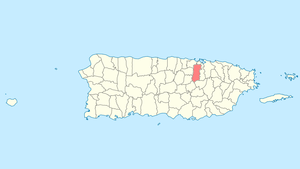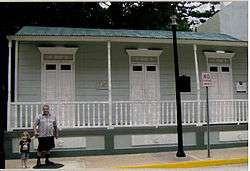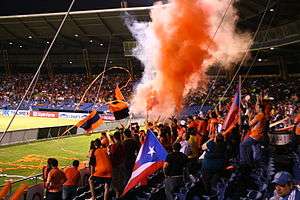Bayamón, Puerto Rico
| Bayamón | |||
|---|---|---|---|
| |||
| Nickname(s): "La Ciudad del Chicharrón" (The Porkrind City), "La Ciudad de Vaqueros" (The City of Cowboys), La Ciudad de las Ciencias ("The City of Science") | |||
| Motto(s): In Hoc Signo Vinces (Latin for: "By this sign you will conquer" | |||
| Anthem: "Bayamón, ciudad hermosa" | |||
 Location of Bayamón in Puerto Rico | |||
| Coordinates: 18°22′48″N 66°09′48″W / 18.38000°N 66.16333°WCoordinates: 18°22′48″N 66°09′48″W / 18.38000°N 66.16333°W | |||
| Country |
| ||
| Territory |
| ||
| Founded | May 22, 1772 | ||
| Government | |||
| • Mayor | Ramón Luis Rivera, Jr. (PNP) | ||
| • Senatorial dist. | 2 – Bayamón | ||
| • Representative dist. | 7, 8, 9 | ||
| Area | |||
| • Total | 115.34 km2 (44.53 sq mi) | ||
| • Land | 114.95 km2 (44.38 sq mi) | ||
| • Water | 0.39 km2 (0.15 sq mi) | ||
| Elevation | 16 m (52 ft) | ||
| Population (2015) | |||
| • Total | 239,116 | ||
| • Density | 2,100/km2 (5,400/sq mi) | ||
| Time zone | UTC-4 (AST) | ||
| Zip code | 00956, 00957, 00959, 00961, 00960, 00958 | ||
| Area code | 787 | ||
| Website | municipiodebayamon.com | ||
Bayamón (Spanish pronunciation: [baʝaˈmon]) is a municipality of Puerto Rico located on the northern coastal valley, north of Aguas Buenas and Comerío; south of Toa Baja and Cataño; west of Guaynabo; and east of Toa Alta and Naranjito. Bayamón is spread over 11 wards and Bayamón Pueblo (the downtown area and the administrative center of the city). It is part of the San Juan-Caguas-Guaynabo Metropolitan Statistical Area.
History
The Taíno people, the historic indigenous peoples who encountered European explorers and settlers, were the long time settlers in this area. The Spanish colonist Juan Ramírez de Arellano established Bayamón as a Spanish settlement on May 22, 1772. Two beliefs exist about the origin of name Bayamón. According to one belief it was named after the local Taíno chief, Bahamon. As per the other belief the name was derived from the Taíno word Bayamongo, which is a river that runs across this region. In turn implying that Bayamón is the area around this main river, which later on became the center of city's development.
In 1821, Marcos Xiorro, an ethnic African slave, planned to lead a revolt against the sugarcane plantation owners and the Spanish Colonial government in Puerto Rico. The slave conspiracy was revealed and suppressed, but Xiorro became a hero among the slaves. He is part of Puerto Rico's folklore. Marco Xiorro was owned by Vicente Andino, a militia captain who owned a sugarcane plantation in Bayamón.[1]
Geography
The Municipality of Bayamón sits on the Northern Coastal Plain region of Puerto Rico. It is bordered by the municipalities of Toa Baja, Cataño, Comerío, Aguas Buenas, Toa Alta, Naranjito, and Guaynabo. Bayamón has a surface area of 43.5 square miles (113.1 km2). The terrain is mostly plain, but includes some peaks such as La Peña and Vergaras.
Bayamón is Puerto Rico's second-largest municipality and is part of the large metropolitan area centered on San Juan. Other cities included in the metropolitan area are Guaynabo, Cataño, Toa Baja, Canóvanas, Carolina and Trujillo Alto. Bayamón is served by the San Juan airport. Despite the city's size, it has no weather reporting station.
Water features
The rivers that pass through Bayamón include the Río Bayamón, Río Hondo, Río Minillas, Río Bucarabones and Río Cuesta Arriba.
Cityscape
Barrios
Bayamón is divided into twelve barrios, with the following populations:
- Buena Vista (15,878)
- Cerro Gordo (34,161)
- Dajaos (2,691)
- Guaraguao Abajo (8,494)
- Guaraguao Arriba (1,681)
- Hato Tejas (46,528)
- Juan Sánchez (25,747)
- Minillas (42,617)
- Nuevo (2,394)
- Pájaros (32,855)
- Pueblo of Bayamón (5,336)
- Santa Olaya (5,662)
- Total (224,044)
Tourism

Bayamón is the site of several notable Puerto Rican landmarks and places of interest. Bayamón Central Park is a public park where people gather and relax. Bayamon also hosts the Braulio Castillo Theater, the Francisco Oller Museum, and the José Celso Barbosa Monument. The Bayamón City Hall building is notable by being built across a major divided highway. While walking through a connecting corridor, right above the road, pedestrians can see passing cars underneath. It is believed to be the only building of its class in the world.[2]
One of the most popular attractions in Bayamón is the Parque de las Ciencias. It is a science-themed park with various exhibitions and attractions. It is the only place, outside of the United States, where NASA rockets and parts are exhibited. It is located in the middle of karstic hills. An observation building on one of the hills gives a good view of the metropolitan area. That building also hosts antennas for government and civil communication.
El parque del tren was a park featuring what was then Puerto Rico's only working train (domestic commercial flights as well as highways and vehicle use had overtaken the railroads in Puerto Rico) It also featured a DC-3, which had been used by United Airlines. In 2001, the park was dismantled and destroyed in the course of major road construction, still underway. What is left of the park is a small plaza for activities and an area for jogging and passive entertainment.
Shopping is also a major tourist activity in Bayamón. Plaza del Sol and Plaza Rio Hondo are major commercial centers in the city. Also, many American restaurant franchises such as Famous Dave's and Olive Garden are first inaugurated in Bayamón before expanding to other locations throughout the island.
A suspension bridge in Bayamón is a pedestrian-only bridge, at the time it was built, it was believed to be one of only three of its kind in Puerto Rico.[3]
Culture
Festivals and events
Bayamón is the site of several annual festivities. The festivities in honor of Santa Cruz, the town's patron saint, are held in May. Also, José Celso Barbosa's birthday is celebrated in July. There's also an artisans festival celebrated that month. Known as La Ciudad del Chicharrón (Pork Rind City), there's a festival dedicated to it in July as well.
Sports


There are several professional and amateur sports team based in Bayamón. The Vaqueros de Bayamón are the local basketball team that plays at the Baloncesto Superior Nacional league. They are currently tied with the Atléticos de San Germán and the Leones de Ponce for the team with the most championships in the history of the league (14), the last of which was achieved in 2009. The team's host venue is the Coliseo Rubén Rodríguez.
The Vaqueros de Bayamón was also the name of the baseball club which played from 1974 through 2003 in the Professional Baseball League of Puerto Rico, and played its home games at Juan Ramón Loubriel Stadium.
The city also has a female volleyball team, called the Vaqueras de Bayamón, which plays for the Liga de Voleibol Superior Femenino.
Recently, Bayamón has become popular for being the hometown of the Puerto Rico Islanders (now known as Puerto Rico FC) of the North American Soccer League. The team plays at Juan Ramon Loubriel Stadium in Bayamón. Another team, Bayamón FC, started playing in the stadium in the Puerto Rico Soccer League in the 2009 season. Sevilla Bayamón FC, now called Sevilla-FC Juncos, used to play in the stadium, until they moved to the town of Juncos due to ownership and financial problems.
The famous boxing fight between Alexis Argüello and Alfredo Escalera dubbed The Bloody Battle of Bayamon (their first; their equally legendary rematch was held in Rimini, Italy) was held in Bayamón in 1978. Also, professional boxers Luis Del Valle, Wilfredo Vazquez and Wilfredo Vazquez Jr. are from Bayamón. International Boxing Hall of Fame member Hector Camacho was born in Bayamon.
| Club | Sport | League | Venue | League Championships |
|---|---|---|---|---|
| Puerto Rico FC | Football | North American Soccer League | Juan Ramón Loubriel Stadium | |
| Vaqueros de Bayamón | Basketball | Baloncesto Superior Nacional | Rubén Rodríguez Coliseum | BSN Championships (14)
|
| Vaqueras de Bayamón | Volleyball | Liga de Voleibol Superior Femenino | Rubén Rodríguez Coliseum | |
Recreation
The municipal government of Bayamón manages a wide variety of recreational programs and recreational facilities for public use. The Onofre Carballeira Sports Complex consists of the Juan Ramón Loubriel Soccer Stadium, home of Puerto Rico's only professional soccer team, the Ruben Rodríguez Coliseum, home of the city's male basketball team and female volleyball team, and the Miguel J. Frau Gymnasium. The Rafael Martínez Nadal Sports Complex's main feature is the Pepín Cestero indoor court, where much of the city's minor league basketball and volleyball major events take place. Also, the Efraín Calcaño Alicea Sports Complex located in the Lomas Verdes community is home to much of the track and field and swimming events in the region. The Honda Tennis Center, inaugurated in 2002, is composed of 16 tennis courts and is used by local tennis clubs as well as visitors.
A pioneer in the development of soccer in Puerto Rico, mayor Ramón Luis Rivera, Jr. inaugurated the Bayamón Soccer Complex in 2011, which consists of three professional soccer fields located off the PR-5 Highway.
The Paseo del Rio (Paseo Lineal) near the Bayamón River is a 6-mile stretch shared by joggers, walkers and cyclists. It is divided in two lanes, one for the bicycles and the other for running or walking. The Rio Bayamón Golf Course is located near one of the endpoints of the trail and is home to most golf activity in the region.
Parque Nacional Julio Enrique Mónagas has trails used by mountain bikers to train and compete. It also has cliffs where rappelling enthusiasts can practice.
The city also has many smaller baseball parks, open basketball courts, soccer fields, gymnasiums, and communal centers available to the community.
Economy
Agriculture
The founding of the town of Bayamón is closely tied to the cultivation of sugarcane. The products currently grown in Bayamón include coffee, grapefruit, sugarcane, tobacco and vegetables. Bayamón was also the site where the first hydraulic sugar mill on the island was built in 1549.[4]
Business
Due to its location within the San Juan Metropolitan area and close to its airport and port, Bayamón is one of the most viable places for commerce. It is also the Puerto Rican city with the most shopping centers and malls. Here are some:
- Plaza del Sol
- Plaza Rio Hondo
- El Cantón Mall
- Plazoleta del Cantón
- Drive-in Plaza
- Bayamón Oeste Shopping Center
- Rexville Towne Center
- Rexville Plaza
- Bayamón Norte Shopping Center
- Plaza di-Luna
- Santa Rosa Mall
- Plaza Del Parque
- Plaza Tropical
- Victory Shopping Center
- Bayamón Shopping City (Under Renovation)
- Bayamón Center (Under Renovation)
- Forest Hills Shopping Center
- Plaza Santa Juanita
- Plaza Bayamón
- Bayamón Towne Center (Under Construction)
- Bayamón Gardens Shopping Center
- Plaza Pradera
Goya Foods has its Puerto Rico offices in Bayamón.[5]
Demographics
| Race – Bayamón, Puerto Rico – 2012 ACS 5-year estimates[6] | ||
|---|---|---|
| Race | Population | % of Total |
| White | 125,458 | 60.5% |
| Black/Afro-Puerto Rican | 15,179 | 7.3% |
| American Indian and Alaska Native | 1,132 | 0.5% |
| Asian | 660 | 0.3% |
| Native Hawaiian/Pacific Islander | 5 | 0.0% |
| Some other race | 17,442 | 8.4% |
| Two or more races or mixed-race persons | 47,481 | 22.9% |
Government
All municipalities in Puerto Rico are administered by a mayor, elected every four years. The current mayor of Bayamón is Ramón Luis Rivera, Jr., of the New Progressive Party (PNP). He was elected at the 2000 general elections, succeeding his father, Ramón Luis Rivera, after 23 years. For a list of all the mayors of Bayamón see "External Links".
The city belongs to the Puerto Rico Senatorial district II, which is represented by two Senators. Migdalia Padilla and Carmelo Ríos Santiago have served as District Senators since 2005.[7]
Symbols
Flag
The current flag of Bayamón features the Scandinavian Cross found in many Nordic Cross flags. It was embroidered by Mrs. Gloria M. León and maintains the design and colors of its coat of arms.
Coat of arms
This shield is a symbol and synthesis of the history and the values which distinguish the city of Bayamón. The main colors of the shield are blue and silver, representing the waters of the Bayamón river and recalling that it was on these banks that the first hydraulic sugarcane refinery of Puerto Rico was established in 1549. The center contains the Holy Cross (Santa Cruz), patron of the first church of the municipality and the name of the old sugarcane refinery "Santa Cruz", which was the historical origin of the town of Bayamón. The sugarcane flowers (guajanas) allude directly to the sugarcane industry that is of social and economic importance to the origin and development of Bayamón.
The five-tower crown, which is used for cities, was assigned to Bayamón as an exception for its extraordinary urban development, the magnitude of its population and for its religious dignity, which will possibly be raised to become Episcopal seat. The motto "IN HOC SIGNO VINCES" makes reference to Emperor Constantine when in the 4th century had the vision in which the victory was promised to him if it accepted the Cross of Christianity as his banner.
Education
Like all municipalities, public education is administered by Puerto Rico Department of Education. Due to its population and location within the metropolitan region, Bayamón is home to many public and private schools. During the 2014-2015 academic year, over 150 public schools ranging from elementary school to high school were located in the Bayamón school region. On the other hand, the city is also home to numerous private schools of which most have a religious affiliation. Some of the better known religious private schools include Colegio De La Salle, Academia Santo Tomás de Aquino, Academia Santa Rosa, Colegio Beato Carlos Manuel Rodríguez, and Academia Discípulos de Cristo (non-Catholic). Non-religious schools in the city include Bayamón Military Academy and the American School.
Bayamón also has many higher-learning institutions such as the University of Puerto Rico at Bayamón, which is one of the eleven campuses that comprise the University of Puerto Rico public university system. Furthermore, the city is also home to some of the most recognized private universities in the island, such as the Interamerican University of Puerto Rico and its School of Optometry, Bayamón Central University, American University of Puerto Rico, Universidad Central del Caribe, and some community colleges. In addition, the Metropolitan University (Universidad Metropolitana), better known as UMET, has a campus in downtown Bayamón.
Transportation

Bayamón is the final stop for the Tren Urbano, with three of its stops located within the city. The Deportivo train station, located off the PR-2 Highway, is near the Santa Rosa Mall, the Bayamón Court of First Instance and the Onofre Carballeira Sports Complex, where the Juan Ramón Loubriel Football Stadium is located.
The city also has a trolley service with regular routes in Downtown Bayamón.
Diplomacy
Bayamón serves as the host city for foreign consular representation in Puerto Rico for the following nations:
Notable natives and residents
- Raymond Acevedo - Singer, actor, former member of Menudo
- Javier Báez - Professional baseball player for the Chicago Cubs
- José Berríos - Professional baseball player for the Minnesota Twins
- Héctor Camacho - Former professional boxer
- Braulio Castillo - Actor
- Virgilio Dávila - Poet and former mayor of Bayamón (1905–1910)
- Rubén Díaz, Sr. - New York State Senator
- Yadier Molina - Professional baseball player
- Felipe López - Professional baseball player
- Ramón Luis Rivera - Former mayor
- Ramón Luis Rivera Jr. - Present mayor
- Agustín Stahl - Medical doctor and botanist
- Wilfredo Vazquez - Professional boxer
- Melissa Mark-Viverito - Speaker of the New York City Council
- Omar Rodríguez-López - Composer, guitarist, and filmmaker
- Braulio Dueño Colón - Musician and composer
- José Antonio Dávila - Postmodern poet
- Pilar Barbosa - Historian, educator and political activist
- Yolanda Mercado - Marathon and long distance runner
- Rene Farrait- singer and actor, former member of boy band Menudo
- Xavier Serbia -singer, actor, show host and economical analyst, former member of boy band Menudo.
- Zabdiel de Jesus- singer, member of boy band CNCO
See also
- List of Puerto Ricans
- History of Puerto Rico
- Puerto Rico Islanders former NASL soccer
- Puerto Rico FC current NASL soccer
- Vaqueros de Bayamón BSN basketball
References
- ↑ Guillermo A. Baralt, Slave Revolts in Puerto Rico: Conspiracies and Uprisings, 1795–1873, Markus Wiener Publishers; ISBN 1-55876-463-1, ISBN 978-1-55876-463-7
- ↑ "Bayamon City Hall, Puerto Rico | By Puerto Rico Channel". www.puertorico.com. Retrieved 2018-07-08.
- ↑ "Bayamon, Puerto Rico | By Puerto Rico Channel". www.puertorico.com. Retrieved 2018-07-08.
- ↑ "Municipalities: Bayamón". enciclopediapr.org. Retrieved 2016-01-11.
- ↑ "Contact Us Archived 2011-04-24 at the Wayback Machine.." Goya Foods. Retrieved on March 26, 2016. "Goya Foods of Puerto Rico, Inc. Urbanización Industrial Luchetti Avenida Francisco de Goya Esquina 5 Bayamon, Puerto Rico 00961"
- ↑ Ethnicity 2010 census
- ↑ Elecciones Generales 2008: Escrutinio General Archived November 20, 2011, at the Wayback Machine. on CEEPUR
Bibliography
External links
| Wikimedia Commons has media related to Bayamón, Puerto Rico. |
- Bayamón and its barrios, United States Census Bureau
- City of Bayamón Official Website (in Spanish)
- Welcome to Puerto Rico - Bayamón

